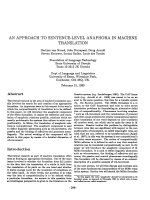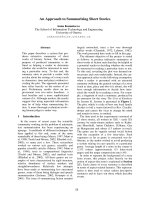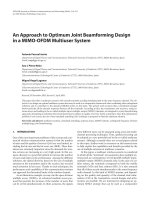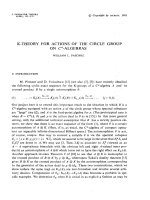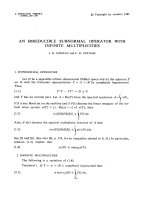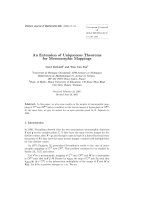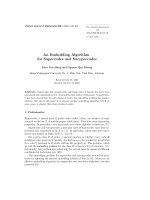Báo cáo toán học: "An Improvement to Mathon’s Cyclotomic Ramsey Colorings" pdf
Bạn đang xem bản rút gọn của tài liệu. Xem và tải ngay bản đầy đủ của tài liệu tại đây (90.97 KB, 5 trang )
An Improvement to Mathon’s
Cyclotomic Ramsey Colorings
Xiaodong Xu
∗
Guangxi Academy of Sciences
Nanning, 530003, China
Stanislaw P. Radziszowski
†
Department of Computer Science
Rochester Institute of Technology
Rochester, NY 14623, USA
Submitted: Oct 28, 2008; Accepted: Dec 9, 2008; Published: Jan 7, 2009
Mathematics Subject Classification: 05C55
Abstract
In this note we show how to extend Mathon’s cyclotomic colorings of the edges
of some complete graphs without increasing the maximum order of monochromatic
complete subgraphs. This improves the well known lower bound construction for
multicolor Ramsey numbers, in particular we obtain R
3
(7) ≥ 3214.
1 Introduction and Notation
A (k
1
, k
2
, . . . , k
m
)-coloring, for integers m, k
i
≥ 1, is an assignment of one of m colors to
each edge in a complete graph, such that it does not contain any monochromatic com-
plete subgraph K
k
i
in color i, for 1 ≤ i ≤ m. Similarly, a (k
1
, k
2
, . . . , k
m
; n)-coloring is
a (k
1
, . . . , k
m
)-coloring of the complete graph on n vertices K
n
. Let R(k
1
, . . . , k
m
) and
R(k
1
, . . . , k
m
; n) denote the set of all (k
1
, . . . , k
m
)- and (k
1
, . . . , k
m
; n)-colorings, respec-
tively. The Ramsey number R(k
1
, . . . , k
m
) is defined to be the least n > 0 such that
∗
partially supported by the National Science Fund of China (60563008) and the Basic Research Fund
of Guangxi Academy of Sciences (080414)
†
corresponding author
the electronic journal of combinatorics 16 (2009), #N1 1
R(k
1
, . . . , k
m
; n) is empty. In the diagonal case, where k
1
= . . . = k
m
= k, we will use
simpler notation R
m
(k) and R
m
(k; n) for sets of colorings, and R
m
(k) for the Ramsey
numbers.
In the case of 2 colors (m = 2) we deal with classical graph Ramsey numbers, which
have been studied extensively for 50 years. Much less has been done for multicolor num-
bers (m ≥ 3). A related area of interest has been the study of generalized Ramsey
colorings, wherein the forbidden monochromatic subgraphs are not restricted to complete
graphs. The second author maintains a regularly updated survey [2] of the most recent
results on the best known bounds on various types of Ramsey numbers.
The next section shows how to improve on the well known construction by Mathon
[1] for establishing lower bounds for R
m
(k).
2 Extending Mathon’s Construction
In 1987, Mathon [1] gave a very elegant algebraical construction of certain m-class cyclo-
tomic association schemes over finite field F
p
, which when interpreted as m-colorings of
the edges of K
p
and K
m(p+1)
give constructive lower bounds for the corresponding classical
diagonal Ramsey numbers. Specifically, for a prime power p = mt + 1 with even t, one
considers the basic m-th residue graph H
m
p
with vertices in F
p
and {x, y} an edge if for
some 0 = z ∈ F
p
, x − y = z
m
, Then, if α is the order of the maximum clique in H
m
p
,
the construction gives m-colorings of the edges of K
p
and K
m(p+1)
with the orders of the
maximum monochromatic cliques equal to α and α + 1, respectively.
In the case of quadratic (m = 2) cyclotomic relations Mathon’s construction is equiv-
alent to the “doubling” of Paley graph described independently by Shearer [3], which,
directly and indirectly, led to several best known lower bounds for Ramsey numbers (cf.
[4]).
Higher order (m ≥ 3) cyclotomic relations beyond the basic H
m
p
so far seem to be
not much exploited in the context of Ramsey constructions. Here, our main interest is
in the Mathon’s cubic association scheme (also pointed to, but not analyzed, by Shearer
[3]). We show how to improve on Mathon’s scheme in the case of cubic residues in Z
p
for
K
3p+3
, though as remarked at the end, a similar improvement holds for all F
p
and m ≥ 2.
In the following we show how to include three additional vertices and obtain a 3-coloring
of the edges of K
3p+6
without increasing the order of monochromatic complete subgraphs.
We begin with a description of Mathon’s construction instantiated for 3 colors over
Z
p
. Let p be a prime of the form p = 3t + 1 with even t, and let β be a primitive element
(generator) of Z
∗
p
. The condition p ≡ 1 (mod 6) implies that −1 ≡ (β
q/2
)
3
(mod p) is
a cubic residue, which is needed for the associated coloring to be well defined. Consider 3-
coloring H
3
p
with the vertex set Z
p
, where the edge {x, y} has color of the cubic character
of x − y in Z
∗
p
, i.e. {x, y} has color i ∈ {0, 1, 2} if and only if x − y ≡ β
3s+i
(mod p),
for some integer s. It is well known that the subgraphs induced in H
3
p
by the three colors
the electronic journal of combinatorics 16 (2009), #N1 2
are isomorphic to each other [1]. Let α
p
denote the order of the largest monochromatic
clique in H
3
p
.
Next, we “triple” the coloring H
3
p
to the coloring M
p
on the vertex set X = U ∪ V of
3p + 3 vertices, where U, V ⊂ Z
p
× Z
p
, |U| = 3, |V | = 3p, and U and V are defined by
U = {u
0
, u
1
, u
2
} = {(0, 1), (0, β), (0, β
2
)},
V = V
0
∪ V
1
∪ V
2
, where V
i
= {(β
i
, a)|a ∈ Z
p
}, for i ∈ {0, 1, 2}.
Each edge e = {(x, y), (s, t)} in M
p
is colored according to the cubic character of
xt − ys in Z
p
. If xt − ys = 0 then e has the special color c ∈ {0, 1, 2} (which later will be
recolored), otherwise e has color i ∈ {0, 1, 2} if and only if xt − ys ≡ β
3s+i
(mod p), for
some integer s.
The main result related to this construction obtained by Mathon [1] is that the order
of any monochromatic clique in M
p
is at most α
p
+1. In addition, the coloring M
p
satisfies
the following properties:
A. Color c induces p+1 vertex disjoint triangles, U is one of them. For each i, j ∈ {0, 1, 2},
u
i
’s neighborhood in color j, N
j
(u
i
), is V
j+1 (mod 3)
.
B. M
p
is vertex transitive, and colors {0, 1, 2} induce isomorphic colorings. Thus, each
vertex x ∈ X has degree p in each color i ∈ {0, 1, 2}, and color i neighborhood of x,
N
i
(x), induces a coloring isomorphic to H
3
p
.
C. If the edge {x, y} has the special color c, then N
i
(x) ∩ N
i
(y) = ∅ for all i in {0, 1, 2}.
Consequently, after an arbitrary recoloring of the edges from color c to colors
{0, 1, 2}, any monochromatic clique in M
p
contains at most one vertex from U
if it contains any vertices not in U.
Theorem 1 For prime p ≡ 1 (mod 6), let α
p
denote the order of the largest monochro-
matic clique in the cubic residues coloring H
3
p
. If k = α
p
+2 ≥ 4 then R(k, k, k) > 3(p+2).
Proof. We will extend the coloring M
p
described above (isomorphic to the construction
by Mathon [1] for m = 3) by three additional vertices to M
p
, without incrementing the
order of the largest monochromatic complete subgraph. We define 3-coloring M
p
of the
edges of the complete graph on the vertex set X∪W = U∪V ∪W , where W = {w
0
, w
1
, w
2
},
and X, U, V are as before. Figure 1 gives the colors of the edges.
The middle 3p × 3p section of the matrix with x’s is defined by the starting coloring
M
p
, while other entries in the rows/columns corresponding to V
i
mean that all the edges
adjacent to this set have the same color as indicated in the matrix.
Let S be the maximum order clique in M
p
in color i. If S ∩ W = ∅ then S is restricted
to original M
p
, so |S| ≤ α
p
+ 1. One can easily check in Fig. 1 that every monochromatic
triangle can have at most one vertex in the set U ∪ W , so we can assume that S ∩ U = ∅
the electronic journal of combinatorics 16 (2009), #N1 3
but there exists x ∈ S ∩ W . By properties B and C of M
p
we have S \ {x} ⊂ V
j
, so again
|S| ≤ α
p
+ 1. ♦
U V W
012 012 012
u0 01 120 012
u1 0 2 201 201
u2 12 012 120
V0 120 xxx 102
V1 201 xxx 021
V2 012 xxx 210
w0 021 102 01
w1 102 021 0 2
w2 210 210 12
Figure 1. Extending coloring M
p
by vertices {w
0
, w
1
, w
2
} to M
p
.
The next corollary improves on the old bound 3211 by Mathon [1]. The new bound
was not published, though it was already cited as an unpublished result in the survey [2].
Corollary R(7, 7, 7) ≥ 3214.
Proof. For prime p = 1069, it is known that α
p
< 6 [1]. The bound 3214 follows from
the Theorem. ♦
One can similarly improve Shearer/Mathon’s construction on K
mp+m
for other values
of m, by producing m-colorings of K
mp+m!
. Note that for m = 2 there is no improvement,
and the case m = 3 is that of the Theorem. For general m with α
p
+ 1 ≥ m, after chosing
the set U (now of m vertices) we add a new set of vertices W so that |U ∪ W | = m!.
With each x ∈ Y = U ∪ W we associate a permutation (i
0
, · · · , i
m−1
) and color all the
edges from x to V
i
j
in color j. For x, y ∈ Y the edge {x, y} has color equal to the minimal
index of the position at which the corresponding permutations are different. We omit
the details since we don’t know any specific parameters with m > 3 for which this would
improve on a best known published lower bound as in the Corollary.
the electronic journal of combinatorics 16 (2009), #N1 4
References
[1] R. Mathon, Lower Bounds for Ramsey Numbers and Association Schemes, Journal of
Combinatorial Theory, Series B, 42 (1987) 122-127.
[2] S. P. Radziszowski, Small Ramsey Numbers, Electronic Journal of Com-
binatorics, Dynamic Survey 1, revision #11, August 2006, 60 pages,
.
[3] J. B. Shearer, Lower Bounds for Small Diagonal Ramsey Numbers, Journal of Com-
binatorial Theory, Series A, 42 (1986) 302–304.
[4] Xu Xiaodong, Xie Zheng, G. Exoo and S. P. Radziszowski, Constructive Lower Bounds
on Classical Multicolor Ramsey Numbers, Electronic Journal of Combinatorics, #R35,
11(1) (2004), 24 pages, .
the electronic journal of combinatorics 16 (2009), #N1 5
